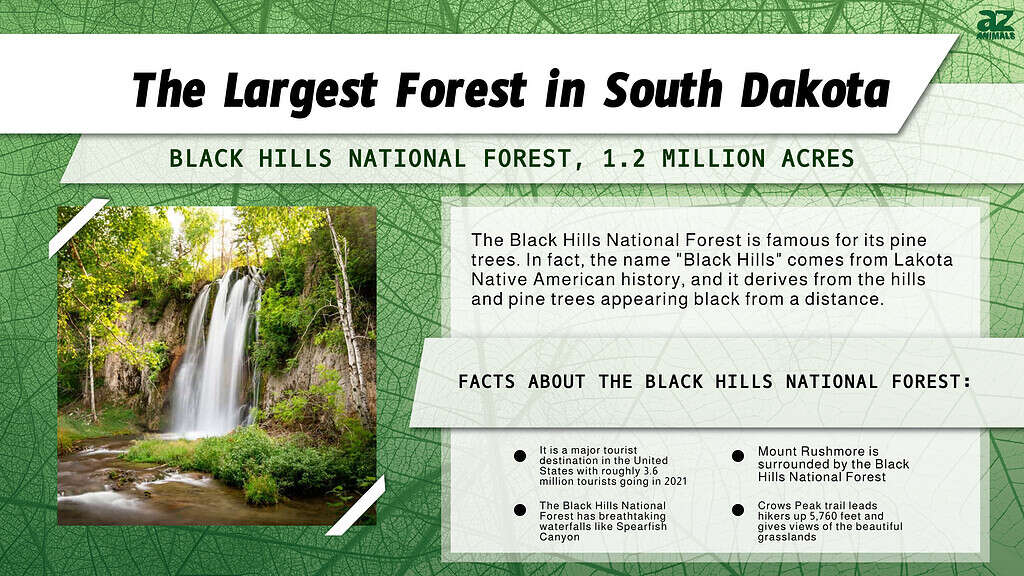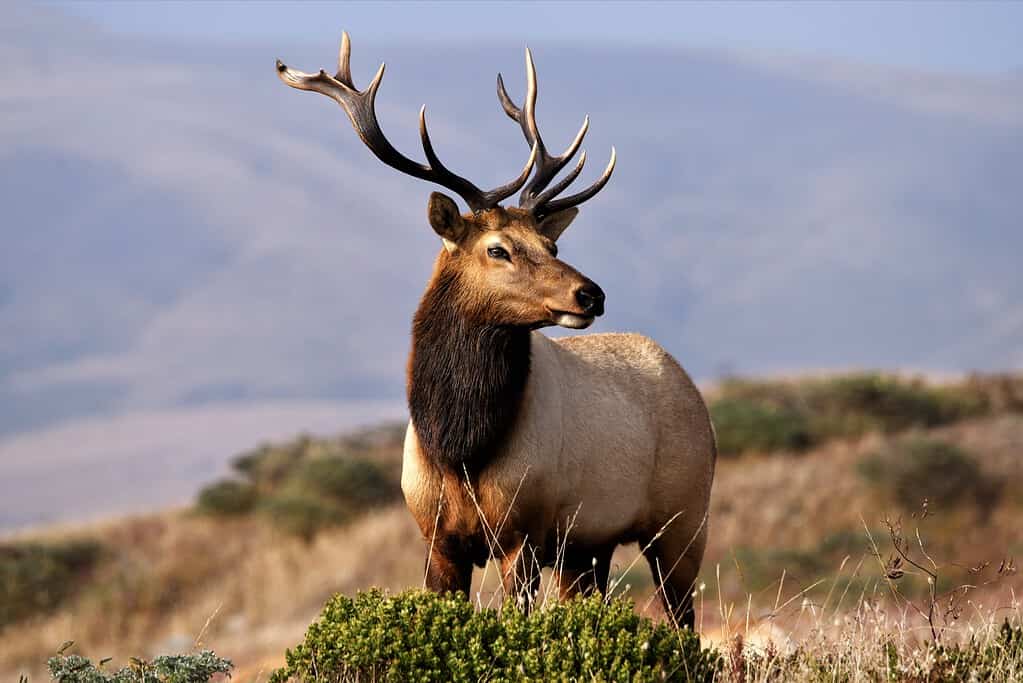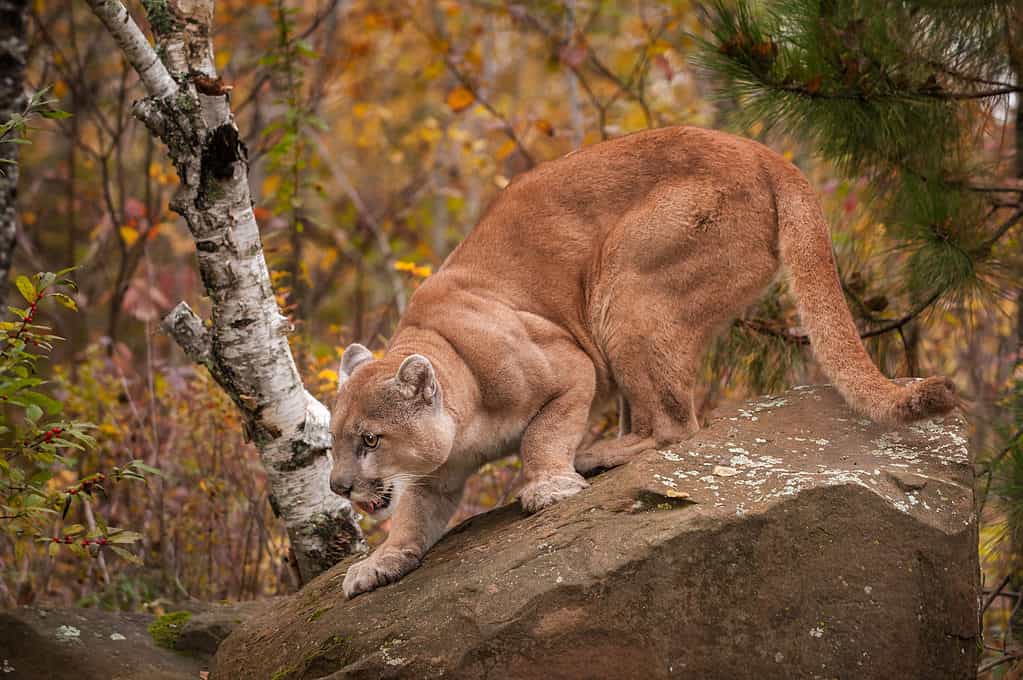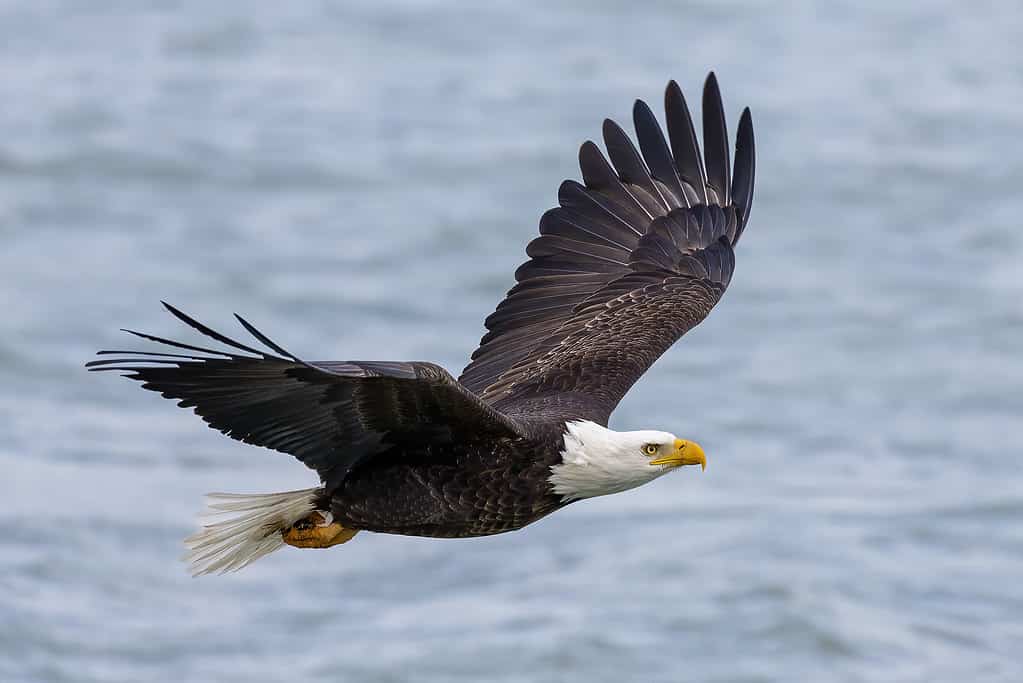South Dakota is part of the Upper Midwest region of the United States. Bordering South Dakota are the states of Minnesota and Iowa to the east, Nebraska to the south, Wyoming and Montana to the west, and, naturally, North Dakota to the north. When you think of South Dakota, sprawling grasslands and farmland is typically the first thing to come to mind.
This is because over 50% of South Dakota is privately and publically owned grassland. South Dakota is 49.35 million acres in total, meaning that roughly 25 million acres total is grassland.
With famous national parks like the Badlands being the first to come to mind in relation to a large amount of grassland area, we shouldn’t forget the beautiful and lush forests of South Dakota.
So, what is the largest forest in South Dakota?

Located within Black Hills National Forest, the Pactola Reservoir is the perfect location for camping.
©RaksyBH/Shutterstock.com
The Largest Forest in South Dakota: Black Hills National Forest
Located in the west of South Dakota, near the Wyoming border, is the Black Hills National Forest. Spanning a massive 1.2 million acres and containing diverse wildlife and famous destinations, the Black Hills National Forest is a major tourist destination in the United States with roughly 3.6 million tourists going in 2021.
Tourists flock to the Black Hills National Forest for its recreation and beautiful views, including the famous Mount Rushmore. With many driving trails running through the park, viewing sights such as the Needle Eye Tunnel are sure to give wonderful memories for years to come.
The Black Hills National Forest is famous for its pine trees. In fact, the name “Black Hills” comes from Lakota Native American history, and it derives from the hills and pine trees appearing black from a distance.
The nature of Black Hills National Forest makes it the perfect place for camping, fishing, hiking, and other recreational activities. No matter the season, Black Hills National Forest is amazing all year, whether you’re resting under the shade of pine trees in the summer or making a snowman in the snow in the winter.

Recreation in Black Hills National Forest

Fun activities for everyone are available at this national forest.
©Structured Vision/Shutterstock.com
Black Hills National Forest offers visitors a variety of options for recreational activities. Whether you are a solo traveler, traveling as a pair, or as a whole family, there is always something available to partake in. With some activities depending on the season, such as skiing in the winter or fall hiking to view the leaves, planning your trip to the Black Hills National Forest is important to get the most out of your time.
Hiking
Hiking in the Black Hills National Forest is perfect for everyone. Whether you are on a backpacking trip or doing a simple day hike, there are a variety of trails available to hike on. Family-friendly hiking trails for those with smaller children are the perfect way to enjoy the beautiful nature and wildlife of the Black Hills National Forest at a pace suitable for everyone.
More challenging trails, such as the Crows Peak trail, allow seasoned hikers to push their limits and see unique and beautiful views. Crows Peak trail leads hikers up 5,760 feet and gives views of the beautiful grasslands. Hiking is the perfect activity for spring, summer, and fall, with each season offering different blooming plants and wildlife. Winter makes hiking difficult given the snow and temperature.
Camping
Whether you like traditional camping in tents or would prefer a cozy log cabin, staying in the Black Hills National Forest is the perfect getaway vacation trip. With over 30 campsites hosting 682 individual plots, there is no shortage of location availability. While most campsites have drinkable water, they do not provide showers or electricity, so pack accordingly.
Beyond the campsites’ amenities, they all provide picturesque scenery. If you’re looking for a waterfront campsite, then locations such as Dalton Lake and Roubaix Lake are the perfect choice. If you’re looking to surround yourself with beautiful pine trees, then Steamboat Rock is perfect. For the log cabin option, only one location is available. The Summit Ridge Cabin was a former fire lookout cabin, giving families that want a unique stay experience fun stories to tell.
Fishing and Hunting
Black Hills National Forest offers a variety of locations in which visitors can hunt and fish. The aforementioned lakeside campgrounds allow for fishing.
This is in addition to fishing, which you can do in the streams and rivers running through the forest, adding up to a total of 15 different locations. If you have any interest in visiting in the winter, consider ice fishing. Ice fishing is allowed on all the lakes in the forest, perfect for your next winter outing.
While designated areas in the forest allow hunting, you must have the proper licenses and permissions. Licenses, which are accessible from the State Game Department, give you the ability to enjoy the hunting season to the fullest. Some of the game species include turkey, elk, mountain goats, rabbits, and bighorn sheep.
Wildlife in Black Hills National Forest
Spanning over 1.2 acres, the Black Hills National Forest has a wide variety of wildlife to explore and enjoy.
Elk (Cervus canadensis)

Over 6,000 elk call Black Hills National Forest home.
©iStock.com/Eric Clark
Elk are the second largest wild herbivore behind the moose. Elk are some of the most social animals within the deer species family, with herd sizes reaching up to 400 or more in the summer. While elk have historically been endangered due to overhunting, they have returned to a stable population and are listed as Least Concern on the IUCN Redlist.
Mountain Lion (Felis concolor)

The strength of mountain lions’ legs allows them to pounce on their prey.
©Holly Kuchera/Shutterstock.com
Mountain lions are some of the strongest predators within any ecosystem. With the only threat to the mountain lion being humans, and sometimes bears, mountain lions have full control of any environment in which they reside. Mountain lion kittens are born with spots on their bodies for camouflage and will fade as they enter adulthood.
Coyotes (Canis latrans)

Coyotes are very vocal animals.
©Warren Metcalf/Shutterstock.com
Late-night howling and yipping distinguish coyotes. In fact, coyotes are one of the most communicative mammals out there. With a wide variety of communication methods such as vocals, body language, and smell, coyotes work best in small packs and often hunt together. The howling can be a bit spooky to hear on a camping trip, though.
Bald Eagle (Haliaeetus leucocephalus)

You can typically find bald eagles near bodies of water and tall trees.
©iStock.com/Karel Bock
The bald eagle is the national bird of the United States and has been since 1782. Bald eagles have strikingly distinct features, such as their white, feathered heads and large wingspan. These birds have amazing vision; they can see four to five times more than the average human. That helps make them the exceptional predators they are.
Western Tanager (Piranga ludoviciana)

Male western tanagers are bright yellow with black wings and an orangish-red head.
©iStock.com/mtnmichelle
Western tanagers are beautiful songbirds, and you can find them in the Black Hills National Forest. With a color gradient of orange to yellow, western tanagers’ feathers are a beauty to behold. They have singing voices that are hoarse and similar to a Robin’s song.
Where Is the Black Hills National Forest Located on a Map?
Located on the western side of South Dakota, on the Wyoming border, the Black Hills National Forest can be accessed through a multitude of roads. Rapid City is one of the closest cities, being just east of the forest. It’s the perfect place to stay during your trip.
Here is Black Hills National Forest on a map:
The photo featured at the top of this post is © iStock.com/John_Brueske
Thank you for reading! Have some feedback for us? Contact the AZ Animals editorial team.






